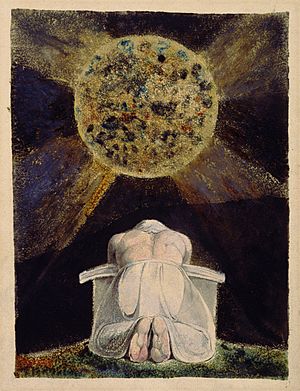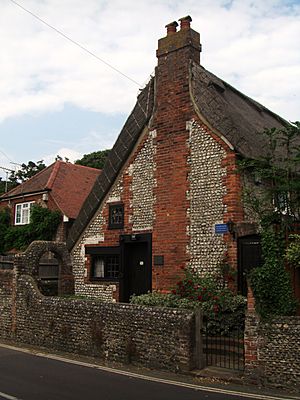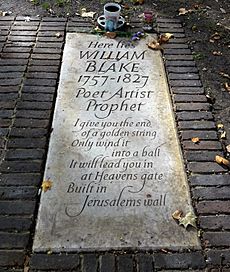William Blake facts for kids
Quick facts for kids
William Blake
|
|
|---|---|
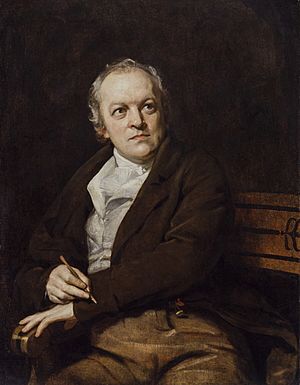
Portrait by Thomas Phillips (1807)
|
|
| Born | 28 November 1757 Soho, London |
| Died | 12 August 1827 (aged 69) Charing Cross, London |
| Occupation |
|
| Education | Royal Academy of Arts |
| Genre | Poetry |
| Literary movement | Romanticism |
| Notable works | Songs of Innocence and of Experience, The Marriage of Heaven and Hell, The Four Zoas, Jerusalem, Milton |
| Spouse |
Catherine Boucher
(m. 1782) |
| Signature | |
William Blake (born November 28, 1757 – died August 12, 1827) was a famous English poet, painter, and printmaker. He is known for his unique way of combining words and pictures. In 2002, he was voted number 38 in a BBC poll of the "100 Greatest Britons."
Contents
William Blake: Poet, Painter, Visionary
Early Life and Dreams
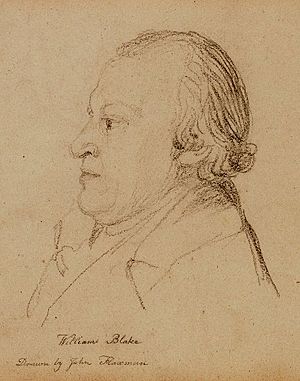
William Blake was born in London on November 28, 1757. He was the third of seven children. His father, James, was a hosier, which means he sold socks and stockings. William only went to school long enough to learn to read and write. After that, his mother, Catherine Blake, taught him at home.
The Bible was a huge influence on William from a young age. He said he had special religious experiences as a child. He described seeing "God's face pressed against his window" and "angels among the haystacks." He even felt visited by the Old Testament prophet Ezekiel.
William started learning art by copying drawings of ancient Greek statues. His father bought these drawings for him. This helped him learn about classical art forms. His parents could afford to buy him many prints and books. This suggests they were quite well-off for a time. When he was ten, his parents knew he was very determined. So, they sent him to drawing classes instead of a regular school. He loved to read books of his own choice. During this time, he also started writing poetry. His early poems show he knew the works of famous poets like Ben Jonson and Edmund Spenser.
Learning to Draw and Engrave
On August 4, 1772, when William was 14, he became an apprentice to an engraver named James Basire. An apprentice learns a skill by working for an expert. He worked for Basire for seven years. After that, at age 21, he became a professional engraver himself.
Basire's style of engraving was a bit old-fashioned. Some people think this might have made it harder for Blake to find work later on. After two years, Basire sent William to copy images from old Gothic churches in London. He spent time in Westminster Abbey. These experiences greatly shaped his art style and ideas.
Art School and New Ideas
On October 8, 1779, Blake became a student at the Royal Academy of Arts. He didn't have to pay for his studies, but he had to buy his own art supplies. At the Academy, he didn't like the popular painters of the time, like Peter Paul Rubens. He felt their style was too messy. Blake preferred the clear, precise style of artists like Michelangelo and Raphael, who had influenced him earlier.
Marriage and Family Life
In 1781, William Blake met Catherine Boucher. She was five years younger than him. They got married on August 18, 1782. Catherine couldn't read or write at first. She signed her wedding paper with an "X." You can still see their original wedding certificate at St Mary's Church, Battersea.
William later taught Catherine to read and write. He also trained her to be an engraver. She was a great help to him throughout his life. She helped him print his special illustrated books. She also kept his spirits up when things were difficult. Their marriage was very close and loving until William's death.
A Creative Career Begins
Around 1783, William Blake's first book of poems, Poetical Sketches, was printed. In 1784, after his father passed away, Blake opened a print shop with a friend. They started working with a publisher named Joseph Johnson. Johnson's house was a meeting place for many important thinkers of the time. These included scientists, philosophers, and writers.
Blake was very hopeful about the French Revolution and the American Revolution. He even wore a special hat, called a Phrygian cap, to show his support for the French revolutionaries. However, he became sad when the French Revolution became violent during the "Reign of Terror." In the same year, Blake started writing an unfinished story called An Island in the Moon. He also illustrated a book by the early feminist writer Mary Wollstonecraft.
From 1790 to 1800, William Blake lived in North Lambeth, London. His house was later taken down, but a plaque marks the spot. There are also 70 mosaics in the railway tunnels of Waterloo station that honor Blake. These mosaics show pictures from his famous books like Songs of Innocence and of Experience and The Marriage of Heaven and Hell.
Making Books with Special Art

In 1788, when he was 31, Blake started experimenting with a new way of printing. He called it "illuminated printing." This method allowed him to create most of his books, paintings, and poems. He would write the text and draw illustrations directly onto copper plates. He used a special ink that resisted acid. Then, he would put the plates in acid. The acid would eat away the parts of the copper that weren't covered by ink. This left the words and pictures standing out in relief.
This was the opposite of how most etching was done at the time. After printing, he would hand-color the pages with watercolors. Then he would stitch them together to make a book. Blake used this special method for many of his most famous works. These include Songs of Innocence and of Experience and Jerusalem.
Engravings for Others
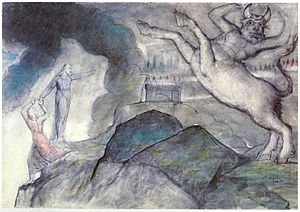
Even though Blake is known for his unique printing method, much of his paid work was traditional engraving. This was the common way to make prints in the 1700s. It involved carving an image into a copper plate. This was a very detailed and slow process. Plates could take months or even years to finish. But it allowed artists to share their work with many people.
One of Blake's engravings is called Europe Supported by Africa and America. It shows three women hugging. Black Africa and White Europe hold hands, showing equality. The ground beneath them blooms. Europe wears pearls, while Africa and America wear slave bracelets. This image was for a book about slavery in Surinam. It shows the ideas about race and slavery that were being discussed at the time.
Blake also used traditional engraving for his own art, like his Illustrations of the Book of Job. He finished these just before he died. These works show how skilled he was as an engraver.
Later Years and Last Works
William Blake returned to London in 1804. He then started to write and illustrate Jerusalem. This was his most ambitious work. In his later life, Blake began to sell more of his art. Many of his Bible illustrations were bought by Thomas Butts. Butts saw Blake more as a friend than a great artist. This was a common view of Blake during his lifetime.
In 1826, Blake received a special request to create engravings for Dante's famous poem, Divine Comedy. He was working on these when he died in 1827. He only finished a few watercolors and seven engravings. But these works are still highly praised today. They show his amazing skill with watercolors and how deeply he understood the poem.
His Final Days
Blake spent his last years living in Fountain Court in London. On the day he died, August 12, 1827, he was still working on his Dante series. It is said that he stopped working and turned to his wife, Catherine, who was crying. He told her, "Stay Kate! Keep just as you are – I will draw your portrait – for you have ever been an angel to me." After drawing her portrait (which is now lost), he put down his tools. He then began to sing hymns and verses. At six that evening, after promising his wife he would always be with her, William Blake passed away.
Blake was buried five days later in a shared plot at Bunhill Fields in London. This was the day before his 45th wedding anniversary. His parents were also buried in the same graveyard. After William's death, Catherine moved in with a friend. She believed that William's spirit visited her regularly. She continued to sell his art and books. But she would always "consult Mr. Blake" before making any business deals. When she died in October 1831, she was as calm and happy as her husband had been.
William Blake's grave is marked by two stones. For many years, the exact spot of his grave was lost. But in 2018, a couple found the exact location after 14 years of searching. A new memorial stone was placed there on August 12, 2018. It reads: "Here lies William Blake 1757–1827 Poet Artist Prophet." It also includes a line from his famous poem Jerusalem.
The Blake Prize for Religious Art was created in Australia in his honor in 1949. There are also memorials to Blake and his wife in Westminster Abbey and St James's Church, Piccadilly.
At the time of his death, William Blake had sold fewer than 30 copies of his book Songs of Innocence and of Experience. His work became much more famous after he died.
Images for kids
-
Blake's Ancient of Days. This image shows a creator figure from the Book of Daniel.
-
A memorial marking Blake's birthplace in Soho, City of Westminster.
-
A memorial to William Blake in St James's Church, Piccadilly.
See also
 In Spanish: William Blake para niños
In Spanish: William Blake para niños



